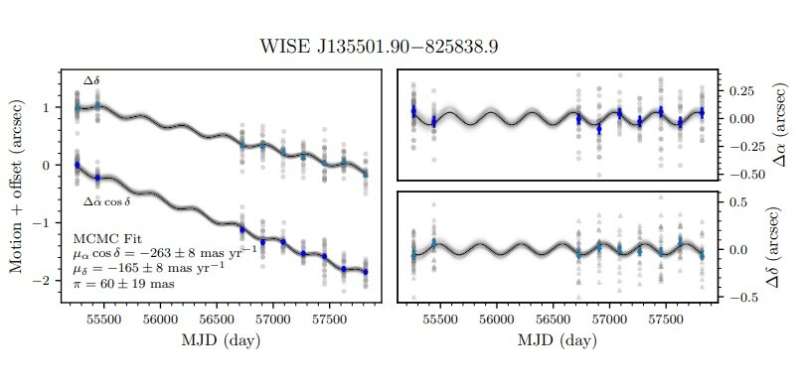WISE parallax solution for WISE J1355-8258 (solid lines). Credit: Theissen et al., 2020.
Using data from NASA's Wide-field Infrared Survey Explorer (WISE), astronomers have investigated a nearby binary system designated WISE J135501.90-825838.9. The new research reports that the studied object is a young, extremely low-mass substellar binary. The finding is detailed in a paper published May 13 on the arXiv pre-print repository.
Binaries with masses not exceeding 0.1 solar masses and ages below 300 million years are generally known as very-low-mass, young binaries. Astronomers are especially interested in the least massive systems of this group, as such objects could provide essential information regarding stellar evolution models.
However, extremely low-mass, young binaries are relatively rare. This is mainly due to the difficulty in locating and identifying such faint systems. To date, the lowest-mass binary detected is 2MASS J11193254-1137466AB, around 10 million years old, with a total estimated mass of some 7.4 Jupiter masses.
Now, a group of astronomers led by Christopher A. Theissen of the University of California San Diego, reports that a nearby system, known as WISE J135501.90-825838.9 (or WISE J1355-8258 for short), is an another example of an extremely low-mass, young binary.
Using the single-epoch astrometry from WISE and the reactivated NEOWISE mission, Theissen's team found that the distance to WISE J1355-8258 is approximately 54.5 light years. This strongly suggests (with a probability of 95.6 percent) that the system is a member of the AB Doradus moving group. Given that AB Doradus is between 130 and 200 million years old, this could also confirm the young age of WISE J1355-8258.
"We find using BANYAN Σ that WISE J1355-8258 has a 95.6 percent probability of being a member of AB Doradus, a 3.4 percent probability of being a member of β Pic, and a 1 percent probability of being a field object," the paper reads.
Furthermore, the study found that the components of WISE J1355-8258 have spectral types L7 and T7.5, while their masses are about 11.0 and 9.0 Jupiter masses, respectively. This makes the system the second lowest mass binary known to date.
However, the astronomers note that previous observations suggest a much higher total mass of WISE J1355-8258, one even pointing to 133 Jupiter masses. They noted that such scenario can not be definitely excluded at the moment, and a more precise parallax solution is required to rule out the possible high-mass of both components.
"With a total mass of ∼ 20 MJup, WISE J1355-8258 is the second-lowest mass binary known, with 2MASS J11193254-1137466AB being the lowest-mass binary currently known (Mtot ≈ 7.4 MJup; Best et al. 2017). Our parallax solution also disfavors Case 1 (Mtot ≈ 133 MJup) and Case 2 (Mtot ≈ 112 MJup) from Bardalez Gagliuffi et al. (2018) at the 3-σ and 2-σ levels, respectively," the astronomers concluded.
More information: WISE J135501.90-825838.9 is a Nearby, Young, Extremely Low-mass Substellar Binary, arXiv:2005.07096 [astro-ph.SR] arxiv.org/abs/2005.07096
Journal information: arXiv
© 2020 Science X Network
























